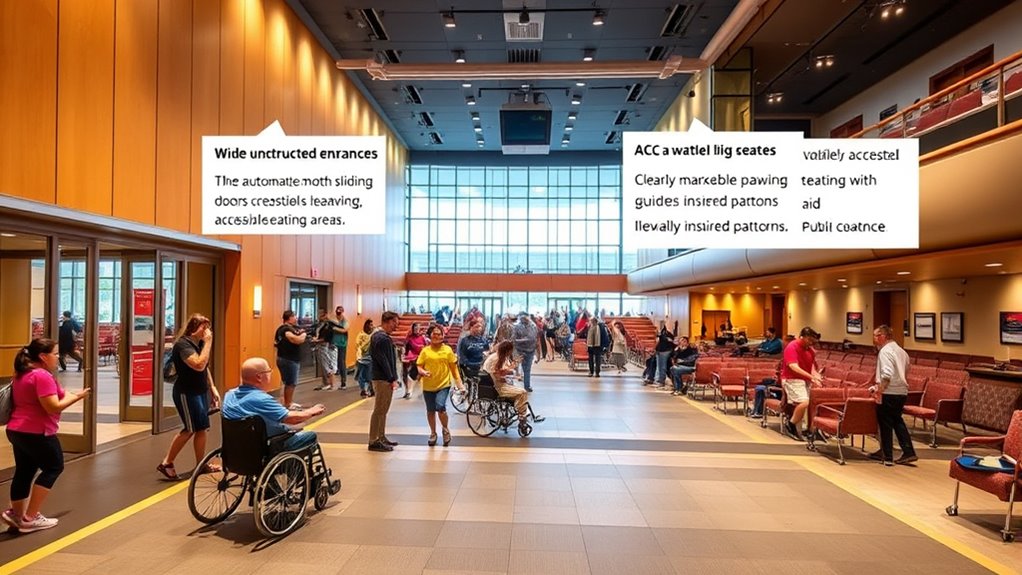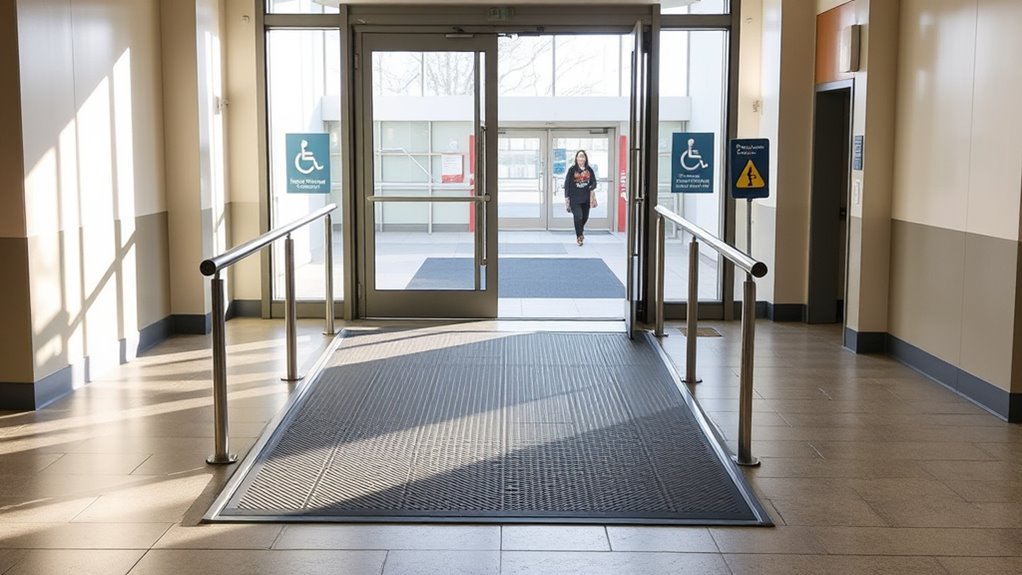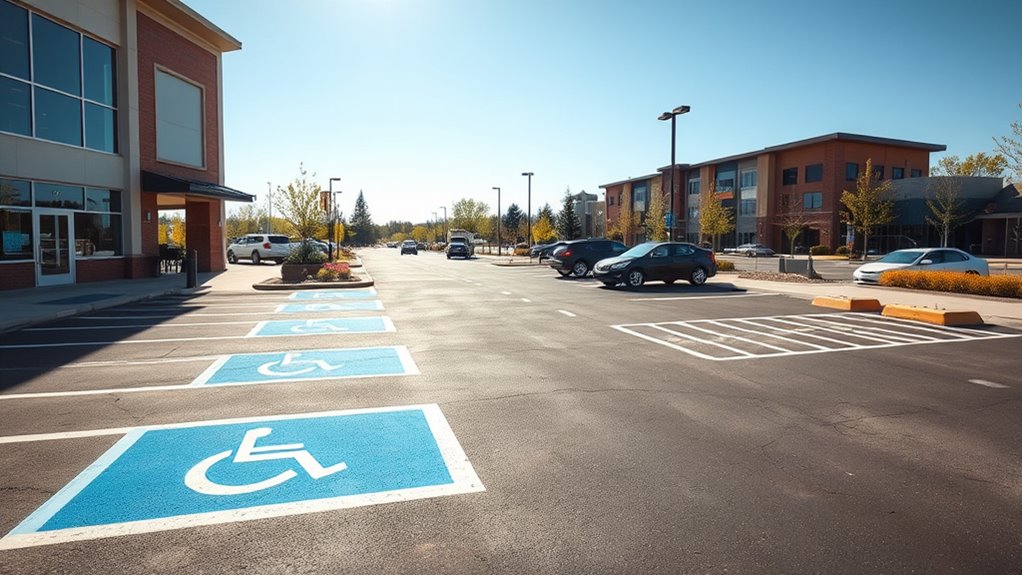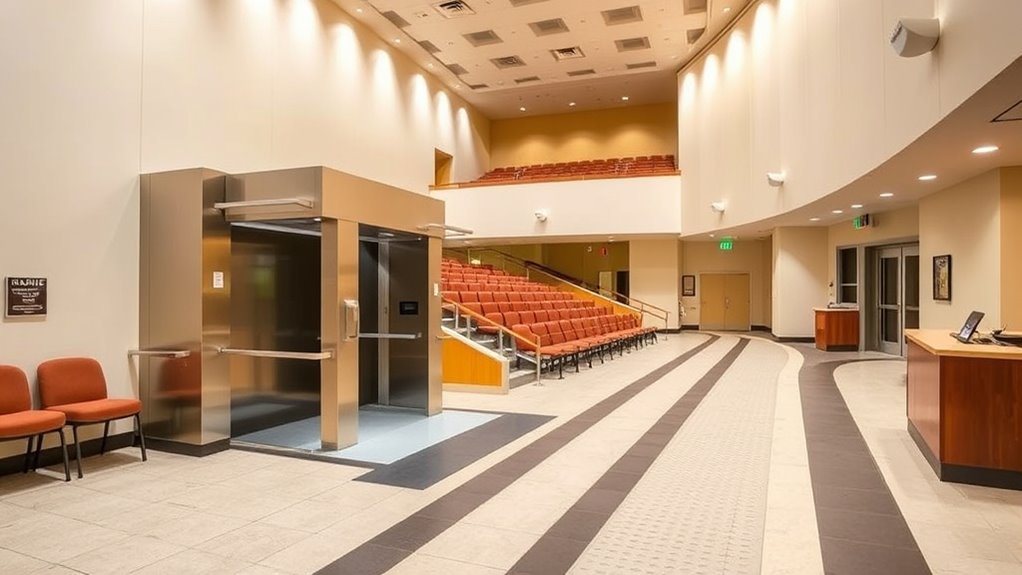When visiting a public venue compliant with ADA Title III, you can expect accessible entrances with ramps and wide pathways, designated parking close to the main entrances, and clear, easy-to-understand signage. Inside, you’ll find features like accessible restrooms, seating areas for mobility devices, and sensory accommodations. Staff will be trained to assist you, and assistive technologies may be available to support communication. Keep going to discover how these features are designed to make your experience comfortable and inclusive.
Key Takeaways
- Accessible entrances, pathways, and signage ensure safe, independent navigation for all patrons, including those with disabilities.
- Designated accessible parking and transportation options facilitate convenient arrival and departure.
- Facilities like restrooms and seating areas are equipped with features supporting safety, comfort, and independence.
- Staff are trained to assist with accessibility needs, recognize service animals, and communicate effectively with diverse guests.
- Regular maintenance and clear signage promote ongoing compliance, inclusivity, and equal access throughout the venue.
Understanding ADA Title III Requirements for Public Venues

Have you ever wondered what it takes for public venues to be accessible to everyone? ADA Title III sets clear standards to ensure inclusivity. You’ll find that venues must provide wheelchair access, including ramps, elevators, and designated seating areas. This makes traversing spaces easier for individuals with mobility challenges. Additionally, service animal policies are strictly enforced; venues must accommodate service animals that assist people with disabilities. This means allowing service animals to accompany their owners everywhere, except in situations where safety is a concern. These requirements aim to eliminate barriers and promote equal access. By understanding these ADA regulations, you can better recognize when a venue is committed to inclusivity and know what to expect during your visit.
Accessible Entrances and Pathways

Accessible entrances and pathways are fundamental to ensuring all visitors can navigate public venues with ease. You should see ramps, wide doorways, and level surfaces that accommodate mobility devices. Clear signage and curb cuts help guide you seamlessly through the space. Assistive technology, such as tactile paving and audible signals, supports those with visual or auditory impairments. If you use a service animal, venues are required to welcome them without barriers, ensuring you can bring your companion inside comfortably. Pathways should be free of obstructions, with smooth, non-slip surfaces. Properly designed entrances and routes demonstrate a venue’s commitment to inclusivity, allowing everyone to access facilities independently and confidently. Color accuracy and contrast ratio are also key factors that impact the overall accessibility and experience of the space for patrons with visual impairments. Accessibility isn’t just about compliance — it’s about creating a welcoming environment for all patrons.
Parking Facilities and Drop-Off Areas

Effective parking facilities and drop-off areas are essential for ensuring all visitors can arrive and depart comfortably. Clear parking signage guides you to accessible spaces, making it easier to find designated spots for individuals with disabilities. These designated parking areas should be located close to accessible entrances and marked with appropriate signage. If valet services are available, they must accommodate patrons with mobility challenges, ensuring drop-off points are accessible and convenient. Properly maintained parking lots with smooth surfaces and enough space for maneuvering help prevent accidents and frustration. Regular maintenance of parking areas is vital to preserve physical safety and accessibility standards. By providing accessible parking and clear signage, venues demonstrate their commitment to ADA compliance and ensure that every visitor, regardless of mobility, can access the venue with ease.
Interior Accessibility Features for Patrons

You’ll want to guarantee that entryways are accessible with ramps and elevators so all patrons can enter easily. Once inside, accessible restrooms are essential for comfort and independence. Addressing these features helps create an inclusive environment that meets ADA requirements. Incorporating accessible signage further assists patrons in navigating the space effectively.
Ramped Entryways and Elevators
Ramped entryways and elevators are essential features that guarantee patrons with mobility impairments can navigate indoor spaces comfortably and safely. Ramps should be positioned at entrances to provide accessible routes, especially when stairs are present. Elevators must be large enough to accommodate mobility devices and should include tactile controls for easy use. These features also support service animals, allowing them to accompany their handlers seamlessly. Additionally, clear signage indicating accessible routes is vital, especially near emergency exits. When an emergency arises, accessible routes ensure everyone can evacuate quickly and safely. Properly maintained ramps and elevators demonstrate a venue’s commitment to inclusivity, making sure all patrons can enjoy the space without barriers or difficulties.
Accessible Restroom Facilities
Are the restrooms within your venue truly accessible to all guests? Ensuring this means more than just having a wheelchair stall; it involves thoughtful interior features. Clear Braille signage helps visually impaired patrons identify restroom locations and understand instructions. Tactile flooring guides guests safely through the space, reducing trip hazards and aiding navigation for those with visual impairments. Make sure fixtures, such as sinks and hand dryers, are within reach and operable with minimal effort. Adequate space for maneuvering, complemented by accessible grab bars, enhances safety and independence. Regularly check that signage is visible and tactile elements are intact. Incorporating sound therapy principles into restroom design can also support calming environments for some patrons. By focusing on these interior accessibility features, you create a welcoming environment where every guest can use your restrooms comfortably and confidently.
Seating and Viewing Area Accommodations

You need to guarantee that seating options are accessible to all guests, including those with mobility challenges. Providing clear viewpoints for everyone and maintaining unobstructed pathways helps create a welcoming environment. These accommodations make a significant difference in how comfortably everyone can enjoy the venue. Incorporating comfortable textiles in seating areas can further enhance guest comfort and accessibility.
Accessible Seating Options
Accessible seating options guarantee that all spectators can enjoy events comfortably and with dignity. When venues provide designated areas, you can expect features like assistive technology and sensory accommodations to enhance your experience. These options assure visibility and proximity, making sure you don’t miss out on any action.
Consider these key features:
- Strategically positioned accessible seats that blend with general seating and include space for mobility devices.
- Clear signage and easy access routes that accommodate sensory needs.
- Integration of sensory accommodations, such as quiet zones or adjustable lighting, to support patrons with sensory sensitivities.
Viewpoints for All
Have you ever missed a crucial moment because your view was blocked or your seat wasn’t easily accessible? Ensuring that viewing areas accommodate everyone is essential. Public venues should offer designated seating that provides clear sightlines for all patrons, including those using wheelchairs or assistive devices. Visual aids like Braille menus and clear signage help guests with visual impairments navigate comfortably. Additionally, venues should support communication needs by providing sign language interpreters or visual alerts so everyone can fully participate. Accessible seating and viewing areas aren’t just about compliance; they create an inclusive environment where everyone feels valued. When venues prioritize these accommodations, you can enjoy events without worry, knowing your experience is designed to be accessible and enjoyable for all.
Clear Pathways Ensured
Making sure clear pathways within public venues is essential for creating a truly inclusive environment. When seating and viewing areas are accessible, you can move freely without obstacles. To achieve this, venues must follow signage standards that clearly mark accessible routes and seating areas. Staff training plays a vital role, preparing employees to assist patrons in maneuvering spaces safely.
Here are three ways venues ensure clear pathways:
- Regularly inspecting pathways to remove obstructions.
- Using compliant signage standards for guidance.
- Training staff to recognize and address accessibility issues promptly.
Restroom Accessibility and Facilities

Are restroom facilities truly accommodating for all visitors? You should find clear, themed restroom signage that directs everyone easily, including those with visual or cognitive disabilities. These signs help patrons quickly identify accessible stalls and facilities, promoting independence and comfort. Additionally, proper restroom maintenance procedures guarantee cleanliness, safety, and functionality, which are essential for a positive experience. Regular inspections and prompt repairs prevent issues like leaks, non-working fixtures, or lack of supplies that could hinder accessibility. When venues prioritize both visual cues and maintenance, they create an environment where all visitors feel welcomed and accommodated. Ensuring accessible restrooms isn’t just about compliance; it’s about respecting every patron’s right to dignity and comfort during their visit. Incorporating restroom maintenance procedures is vital for maintaining accessibility standards and ensuring ongoing compliance with ADA regulations.
Additional Services and Communication Accessibility

How accessible are the additional services and communication methods provided at your venue? You should find that venues offering assistive technology, like captioning devices or hearing loops, enhance communication for all patrons. Clear service animal policies are equally important, ensuring that service animals are welcomed and accommodated appropriately. Incorporating AI-driven solutions can further improve accessibility by providing innovative tools for communication and assistance.
Frequently Asked Questions
How Often Are Public Venues Required to Update ADA Compliance Features?
You might wonder how often venues need to update ADA compliance features. Generally, maintenance schedules are set to keep accessibility features in good condition, and compliance audits are performed regularly to guarantee ongoing adherence. While there’s no strict timeline, many venues review and update their accessibility measures annually or after significant changes. Staying proactive with maintenance and audits helps ensure you experience accessible and compliant facilities every time you visit.
Are There Specific Penalties for Non-Compliance With ADA Title III?
You might wonder about ADA enforcement and legal penalties if venues don’t meet requirements. Non-compliance can lead to legal penalties, including fines, lawsuits, and orders to make immediate accessibility improvements. The ADA aims to guarantee equal access, so authorities actively monitor and enforce these standards. If you experience barriers, you can report them, prompting venues to address issues and avoid penalties, fostering a more inclusive environment for all patrons.
Can Patrons Request Specific Accommodations Not Visibly Available?
Imagine a world where your needs are truly valued. You can request accessibility modifications that aren’t visibly available, and venues are required to contemplate these requests seriously. You have the right to ask for reasonable modifications to ensure equal access. While venues aren’t obliged to grant every request, they must evaluate each one in good faith, making your experience more inclusive and accommodating.
How Can Patrons Report ADA Compliance Issues at a Venue?
If you notice ADA compliance issues at a venue, you should follow the complaint procedures provided by the venue, often available on their website or at the entrance. You can also submit accessibility feedback directly to management or customer service. Clearly describe the issue, and request prompt action. Reporting problems helps guarantee the venue addresses accessibility concerns and improves the experience for all patrons.
Are Service Animals Allowed in All Areas of Public Venues?
Service animals serve as essential allies for many, but policies vary. You might find that service animals are permitted in most areas, but some venues restrict access to certain spaces. Always check the venue’s service animal policies and look for clear accessibility signage. By doing so, you’ll stay informed, ensuring your service animal’s access aligns with venue policies, promoting a positive, protected, and pleasant experience everywhere you go.
Conclusion
Ensuring ADA Title III compliance isn’t just about legal requirements—it’s about creating welcoming spaces for everyone. Did you know that nearly 1 in 4 adults in the U.S. has a disability? By understanding and supporting accessible features, you’re helping to break down barriers and foster inclusivity. When venues prioritize accessibility, they not only meet regulations but also show genuine care for all patrons. Together, we can make public spaces more welcoming and equitable for everyone.











